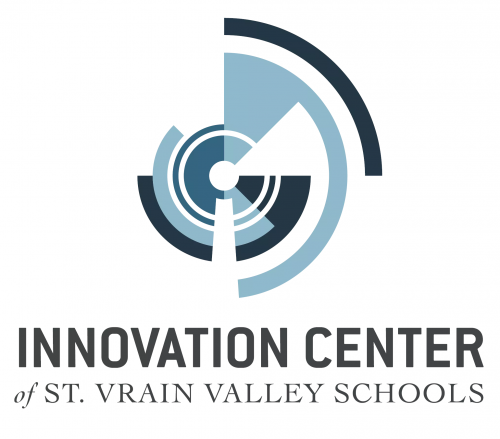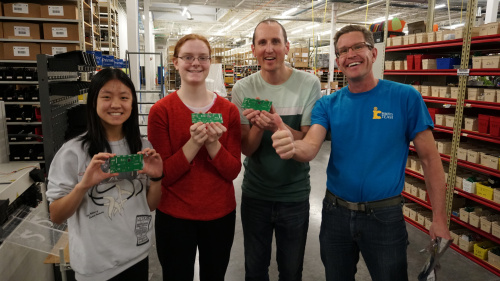×
SparkFun will be closed on Tuesday, December 24th, and Wednesday, December 25th, in observance of the Christmas holiday. Any orders qualifying for same day shipping placed after 2:00 p.m. (MST) on Monday, December 23rd, will be processed on Thursday, December 26th, when we return to regular business hours. Wishing you a safe and happy holiday from all of us at SparkFun!
Please note - we will not be available for Local Pick up orders from December 24th-December 27th. If you place an order for Local Pick-Up we will have those ready on Monday, December 30th.
Over the last two years, a few SparkFun employees and I have been gathering, every Thursday afternoon, at the St. Vrain Innovation Center up in Longmont, CO. There, we volunteer with the Innovation Center Aquatic Robotics Team (ICART). Recently, with the help of one of my coworkers, QCPETE, the students involved with Project Canary assembled their first custom PCB design. This is the story behind their project and their experience with the design and assembly process.
Project Canary: Atmospheric Research Takes Flight
Written by Davita Bird and Caitlyn Fong
In 2017, Janine Aquino and Kate Young of the University Center for Atmospheric Research (UCAR) contracted with the St. Vrain School District Innovation Center to outfit a quadcopter with sensors so that they could conduct low-altitude atmospheric research. From this, the Canary Drone Team was born. For this project, six Innovation Center students (Michelle, Davita, Aidan, Ben, Pi and Morgan), together with team mentor Craig Rahenkamp, were tasked with recommending a quadcopter to purchase, designing and constructing a sensing array that could be attached to the drone and relay data to a ground station, and developing a method for transmitting this data to an on-line database.
The team ended up choosing a DJI Phantom drone because of its flight time and high load capacity. They then designed the circuitry and created code for an Atmel chip (1284 PA if anyone’s interested) to communicate with five gas sensors (NH3, CO2, O3, H2 and CH4), a LiDAR sensor, a GPS sensor and a BME280 sensor (measures temperature, pressure and humidity), which then transmits all of that data through an XBee radio. The data package is received by a second radio attached to a phone, which then transfers the data to a CHORDS database in the cloud.
In order to attach this sensor suite to the drone, the team had to design its own circuit board for the sensors. This process took about a year, during which one of our circuit board team members graduated (as did most of the rest of the team, darn them all!), leaving a three-and-a-half member team to finish the project. One of the graduates, Michelle, worked remotely to finished the cell phone code during her first year of college, with help from Jim Foltz, a team mentor. The project is nearly done, with the airborne code essentially finished and only testing remaining. The students were very lucky to have Pete, a SparkFun mentor, to help with the process of creating the circuit board and helping Caitlyn and Davita mount the components. Through all the phases of the circuit board creation, SparkFun was instrumental in helping the team have some idea of what to do, not to mention providing the opportunity to see the manufacturing tools in action in the warehouse.
Final PCB Design. (Click to enlarge)
in February, Caitlyn and Davita, and their mentor Craig Rahenkamp, went to SparkFun headquarters to surface mount components on our newly designed and printed circuit boards. The first generation of boards ended up getting the guidelines printed as signal traces (oops), so this time the team had a SparkFun mentor check and recheck our student design made by Manas. SparkFun then helped the team get the boards manufactured by sending the design out to JLCPCB. Once delivered, these new boards were taken to SparkX, the R&D/rapid prototyping side of SparkFun.
Caitlyn applying solder paste to one of the boards for the layout process.
At one of their available desks, Caitlyn and Davita put solder paste on them with the help of stencils that were specifically created for the board, and got them ready for the next step: surface mounting the components. For this part, Caitlyn and Davita carefully transported the boards downstairs, where SparkFun does their board assembly. Using tweezers, Caitlyn and Davita placed five LEDs, 19 capacitors, 12 resistors, one inductor and the microchip onto the three boards. Most of these parts were smaller than ants, measuring just 0.3 mm by 0.6 mm. From there, the students were able to use the huge oven to heat our boards and finish the soldering process. While the boards were being heated, the students and mentors were able to watch a pick-and-place machine mount the parts for a panel of SparkFun boards. This machine is used to quickly and accurately mount parts on larger batches of circuit boards.
Caitlyn, Davita, Pete and Craig with the completed boards.
Project Canary was able to take a large step forward with the help of SparkFun and the opportunities it offered the team. Going to SparkFun helped enhance students' and the mentor's knowledge on circuit boards, the art and science of soldering, and surface mounting smaller components. It was a really fun, hands-on activity, and it helped give the students ideas for future careers and jobs.
Team Bio:
Our current team is three full-time students (Davita Bird, Caitlyn Fong and Manas Saini), one half-time student (Michelle Tran) and our mentor Craig Rahenkamp. The team has been in existence for two years.
If you are a technical professional and are interested in volunteering, you can reach out to Axel Reitzig, the Robotics and Computer Science Coordinator at the St. Vrain Innovation Center. Additionally, you can visit the St. Vrain Valley School District's Community Strong platform to learn about other opportunities to get involved.
Students in the St. Vrain Valley School District who are interested in working (possibly paid) on projects like this can apply for positions through the St. Vrain Innovation Center.
Students in the St. Vrain Valley School District who are interested in working (possibly paid) on projects like this can apply for positions through the St. Vrain Innovation Center.










AWESOME!!!
Check them out, when you come back for a visit... they have some other cool projects like a shark measuring probe.
I've got to admit, a google search of that phrase wasn't nearly as interesting as I thought it would be.
Haha, my bad... they called it a "shark wand". However, I'm not sure if you'll get good results using those search parameters either. Here is their blog post on the device. It essentially uses lasers to quickly measure the length of sharks for research data.
What an awsome learning opportunity for the students! As a retired Engineer, I wish I could find something similar to volunteer my time to help with in the Phoenix "East Valley" area (though at the moment I'm out of town).
We luckily stumbled upon this program; however, you might be able to find a similar center in your area. Based on the needs at the Innovation Center, they were eager to have any mentors with experience or knowledge to assist with the students. I highly recommend it, if you find an opportunity to help.
It's been a few days since a post. But you made it worth it! What a great way to give back and support the community!!
Thanks for the encouragement!
Sounds like quite a neat experience. I hope to see another blog post when these boards take flight!
I think once they get everything up and running, the team wants to do a follow-up post as well. I don't think they have a hard deadline on the project, so I'm not sure when that will be though.